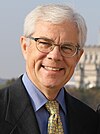The following table indicates the party of elected officials in the U.S. state of Ohio:
In the United States, a governor serves as the chief executive officer and commander-in-chief in each of the fifty states and in the five permanently inhabited territories, functioning as both head of state and head of government therein. As such, governors are responsible for implementing state laws and overseeing the operation of the state executive branch. As state leaders, governors advance and pursue new and revised policies and programs using a variety of tools, among them executive orders, executive budgets, and legislative proposals and vetoes. Governors carry out their management and leadership responsibilities and objectives with the support and assistance of department and agency heads, many of whom they are empowered to appoint. A majority of governors have the authority to appoint state court judges as well, in most cases from a list of names submitted by a nominations committee.

The 2010 United States elections were held on Tuesday, November 2, 2010, in the middle of Democratic President Barack Obama's first term. Republicans ended unified Democratic control of Congress and the presidency by winning a majority in the House of Representatives.
The following table indicates the party of elected officials in the U.S. state of Arkansas:
The following table indicates the party of elected officials in the U.S. state of Colorado:
Illinois is a Democratic stronghold in presidential elections and one of the three largest Democratic states in the nation alongside California and New York. It is one of the most Democratic states in the nation with all state executive offices and both state legislative branches held by Democrats. For most of its history, Illinois was widely considered to be a swing state, voting for the winner of all but two presidential elections in the 20th century. Political party strength in Illinois is highly dependent upon Cook County, and the state's reputation as a blue state rests upon the fact that the majority of its population and political power is concentrated in Chicago, Cook County, and the Chicago metropolitan area. Outside of Chicago, the suburban collar counties continue trending Democratic while downstate Illinois can be considered more conservative with some moderate regions.
The following table indicates the party of elected officials in the U.S. state of Mississippi:
The following tables indicate the historic party affiliation of elected officials in the U.S. state of Wisconsin, including: Governor, Lieutenant Governor, Secretary of State, Attorney General, State Treasurer, Superintendent of Public Instruction. The tables also indicate the historical party composition in the State Senate, State Assembly, the State delegation to the United States Senate, and the State delegation to the United States House of Representatives. For years in which a United States presidential election was held, the tables indicate which party's nominees received the state's electoral votes.

In the United States, 45 of the 50 states have an office of lieutenant governor. In two of the 45 states, the speaker of the upper house of the state legislature serves in such a capacity. In most cases, the lieutenant governor is the highest officer of state after the governor, standing in for that officer when they are absent from the state or temporarily incapacitated. In the event a governor dies, resigns or is removed from office, the lieutenant governor typically becomes governor.

The 2001 United States elections were held on November 5 of that year. The 2001 recession was a dominant issue throughout the year as well as the September 11 attacks and subsequent War on Terror.

The 1996 United States elections were held on November 5. Democratic President Bill Clinton won re-election, while the Republicans maintained their majorities in both houses of the United States Congress.

The 2022 United States elections will be held on Tuesday, November 8, 2022, in the middle of the term of the president elected in 2020. During this mid-term election year, all 435 seats in the United States House of Representatives and 34 of the 100 seats in the United States Senate will be contested. 39 state and territorial governorships and numerous other state and local elections will also be contested. This will be the first election affected by the redistricting that will follow the 2020 United States Census.



























































